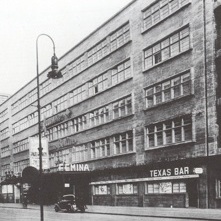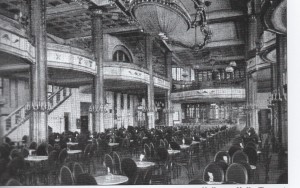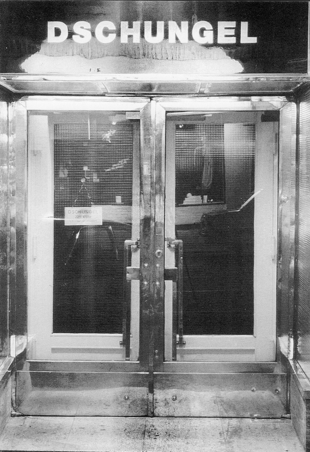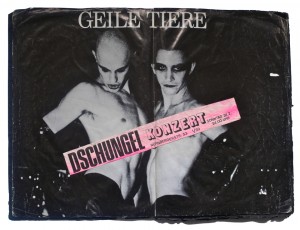

Femina-palast
“Sitting in the Dschungel, on Nürnberger Straße
A man lost in time
Near KaDeWe.”
David Bowie, January 2013 – Where Are We Now
The Femina-Palast was built in 1928 by architects Richard Bielenberg and Josef Moser for businessman Heinrich Liemann. Occupying Nürnberger Straße 50-53 on the border of Schöneberg and Charlottenberg and at 185 metres long, it is one of the most important examples of the ‘New Objectivity’ style built in the city.

(image – Fritzhirzel.com)
Primarily consisting of offices and shop fronts, at the core of the building was the spectacular Femina-Palast ballroom, a combination of Art Deco and Bauhaus design.
The ballroom doubled as a vaudeville theatre and featured performances by Josephine Baker amongst others. Patrons were served by flamboyant, transvestite waiting staff , there were telephones on the tables, and over the dance floor was a spectacular glass-domed roof that could be opened to give the feeling of dancing under the stars. At the corner of the street was the extraordinary ‘Kaffee Tauentzienpalast’ coffee house.

The ballroom was severely damaged in the Second World War, but by the 1950s had reopened as the ‘Badewanne’ – a jazz club that became famous in West Berlin featuring appearances by Count Basie, Ella Fitzgerald and Duke Ellington and was hugely popular with American GIs and the other Allied Forces. It was also home to the cabaret group ‘Die Stachelschweine’.
The building was, by this time, generally known as The Tauentzienpalast and, from 1950 to 1957, housed the 900- seat ‘Cinema Im Tauentzienpalast’.

In the early 1960s, a ground-breaking Chinese restaurant “San Lin Nan” was added to the building, designed by architect Chen-Kuen Lee, a Berlin resident since the early 1930s.
In 1978, Berlin’s up-and-coming ‘Dschungel’ discotheque moved from nearby Winterfeldplatz into Nürnberger Strasse and rapidly became the stylish and sought-after place to be – Berlin’s equivalent to New York’s ‘Studio 54′.
A spiral staircase from the main club took VIP guests to the loft space ‘The Aquarium’ which featured fountains and the beautiful, ornate mosaic tiling left over from its days as the ‘San Lin Nan’ restaurant.

(image – druffmix.com)

(image – lucianocastelli.com)
From 1978 to 1993, a ‘who’s who’ of stars passed through the doors of the ‘Dschungel’ – David Bowie and Iggy Pop, Frank Zappa, Grace Jones, Mick Jagger, Prince, Boy George, Barbra Streisand and, of course, Depeche Mode.
For ordinary customers – if you got past the bouncers – the door charge was a hefty 10 Deutschmarks!
The club fell out of fashion in the early 90s and closed its doors in 1993. Its successor, the ‘Dschungel Restaurant’, only lasted a further three years before the building closed down completely in 1996, lying empty for the next nine years.
In 2005 , the local authority, Bezirk Templehof-Schöneberg, accepted a proposal for a €40 million conversion of the historic building into the 285-room Ellington Hotel, which opened in March 2007.

